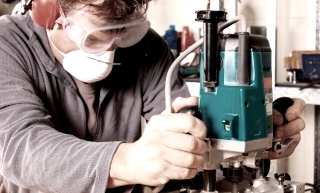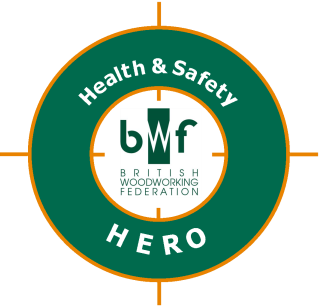 Jon Gorf, BWF Technical and Health & Safety Consultant
Jon Gorf, BWF Technical and Health & Safety Consultant
Health and Safety Update
Health and Safety is often combined into one ill-defined heading whereas it should be thought of as two distinct areas. Safety is the protection of people from physical injury, the consequences of a failure can become quickly visible. Health is the protection of bodies and minds of people from illness resulting from the materials, processes or procedures used in the workplace. The effects of failure of health can take longer to materialise. For example, exposure to asbestos may take years to develop into asbestosis and with chronic consequences.
There are an estimated 13,000 deaths each year primarily linked to dust and chemical exposures at work and 14,000 estimated new cases of breathing or lung problems annually (source HSE Health and safety at work Summary statistics for Great Britain 2016).
Wood dust (hardwood and softwood) can cause serious health problems and, if not managed correctly, can lead to occupational asthma or cancer, particularly of the nose (sino-nasal cancer). As part of the HSE Sector Plan for 2017-18 inspectors, are targeting sites that carry out woodworking processes looking at wood dust and local exhaust ventilation (LEV) controls. In the next quarter, it is expected that 2500 companies within the wood sector will be visited.
Joiners and carpenters are four times more likely to develop asthma when compared to other UK workers. As an employer, you have a legal responsibility to protect your worker from this hazard and to reduce dust levels to a minimum, as defined in the Control of Substances Hazardous to Health (COSHH) Regulations 2002.
What do I need to do?
You must provide dust extraction (LEV) at woodworking machines to capture and remove dust before it can be spread. The current Workplace Exposure Limit (WEL) is 5mg/m3 however, this is likely to be reduced to 2mg/m3. This lower level is already being worked towards in parts of Europe and the UK will follow and, whilst the timescale for this has not been set, you should start planning now on how you will be able to achieve this.
LEV must have a Thorough Examination and Test to Regulation 9 of COSHH carried out by a competent person at least every 14 months. You are responsible for making sure that your supplier is competent to do the job. A competent person should have the right mix of skills, knowledge and experience to do a good job. Ask about relevant qualifications and training, experience and previous work. A competent supplier will be able to supply references or testimonials – ask for them. If the cost is high, it might be worth visiting other sites and viewing other LEV installed by the supplier. A good supplier should also be able to train your staff to maintain the LEV.
A commissioning report should be issued after first installation of the LEV system. This details the performance achieved and system limitations. It then forms the baseline performance information for all future statutory inspections to measure against. The law says that you need to make sure it carries on working properly and so you should keep a logbook that includes schedules of regular checks and maintenance. Then, at every 14-month inspection, the user should receive a report summarising how the equipment is performing against the original commissioning report and regulatory requirements.
If you have an LEV system that hasn’t been commissioned you must have its performance tested to ensure that it is working correctly.
What will happen if I don’t use LEV?
Fundamentally you will be putting you and your workers health at risk. This is classed as a ‘Material Breach’ by HSE and you will be liable for a fine known as Fee For Intervention (FFI). The current rate for FFI is £129 per hour. The inspector will charge for all the time they have spent identifying the breach, investigation and any enforcement action. A typical fee is in the region of £600
 Can’t I use dust masks as an alternative?
Can’t I use dust masks as an alternative?
No. There is a hierarchy of control when it comes to reducing risks. This means risks should be reduced to the lowest reasonable level by taking preventative measures in order of priority. The levels are: –
1. Elimination. Substituting for another product.
2. Substitution. Replace the process with a less hazardous one.
3. Engineering controls e.g. LEV
4. Administrative controls. Implementing procedures to work safely
5. Personal Protective Equipment (PPE) and Respiratory Protective Equipment (RPE) are the last resort when all previous measures have been tried and found ineffective.
What about hand-held sanding machines?
Where possible you should buy equipment with on-tool extraction ideally connected to a Type H vacuum cleaner. On-tool bags perform less well. On-tool extraction must also be checked as per the Thorough Examination and Test to Regulation 9 of COSHH.
When using hand-held sanding machines it is likely you will also need RPE. It is important to check that the RPE you select provides suitable and adequate protection. Tight face fitting RPE will only work on clean shaven faces and is ineffective when used with beards or stubble. Disposable masks should be at least FFP3. You should carry out Face Fit Testing to provide evidence that dust masks are effective.
– For more information on any of the above then please contact Jon Gorf at the BWF by e-mail (jon.gorf@bwf.org.uk) or through the Health & Safety Helpline.
– Here you can find out why imprisonment and huge fines are now on the table for joinery workers and businesses flouting Health & Safety law.
 Those who are concerned that they are unprepared for an HSE inspection visit are reminded that they can access comprehensive support from the BWF ‘Toolkit’, which includes our Health & Safety member helpline and publications on what the inspectors are looking for including HSE Field Operations Directorate Guidance for proactive inspections, and the Health and Safety essentials checklist. These two Fee For Intervention guidance briefing notes are available through the website by logging in as a BWF member.
Those who are concerned that they are unprepared for an HSE inspection visit are reminded that they can access comprehensive support from the BWF ‘Toolkit’, which includes our Health & Safety member helpline and publications on what the inspectors are looking for including HSE Field Operations Directorate Guidance for proactive inspections, and the Health and Safety essentials checklist. These two Fee For Intervention guidance briefing notes are available through the website by logging in as a BWF member.
There is also free-to-members guidance on Health & Safety in the woodworking industry and documents such as Machine Safety Cards, sample inspection forms, and sample risk assessments.
Additionally you may wish to undertake a Health & Safety Audit that will not only suggest where your health and safety needs to be improved, but also how to achieve it. The BWF has negotiated exclusive rates with experienced Health & Safety advisors for a simple value for money package.
Last but not least, pledge your support to the BWF Health & Safety Hero Campaign, where we have put together some excellent resources to help your business tackle problem areas such as wood dust, machine training, noise, manual and handling. All of which may help in avoiding potential costs of FFI and perhaps more importantly ensure the health and welfare of all employed in your joinery business!
The British Woodworking Federation is the trade association for the woodworking and joinery manufacturing industry in the UK. Thinking of becoming part of it? Use this quick response form to provide us with some contact details. We will send you an email to confirm your interest and then one of our experienced membership team will be in touch to complete the membership process.